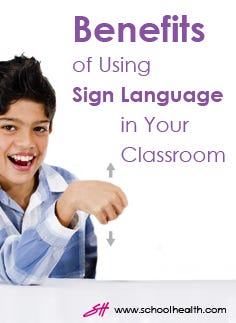Benefits of Using Sign Language in Your Classroom

General education classrooms are becoming more diverse. Children with a variety of disabilities and from diverse cultural and economic backgrounds are mainstreamed into the general education environment. This makes it difficult for one teacher to reach all the students using one single type of learning style.
Teachers are constantly searching for new ways to engage their students in the learning process. Using sign language within the classroom is one solution to reach all learners. Sign language can enhance the learning process by bringing visual, auditory and kinesthetic feedback to help reach all students.
Teachers are using sign language to:
- Manage students behavior
- Keep students actively engaged
- Assist students in literacy development of phonics, reading, and spelling
- Assist students in speech development
- Assist students in language development
- Promote positive peer to peer communication and interactions
Research has shown that pairing signs with English help learners formulate mental pictures. This multi-modal experience can help create new pathways in the brain for storage and retrieval. This helps students remember and recall sight words and spelling words (Daniels, 2001). Studies have also shown that students who learn sign language for specific sight words learn to read at a faster rate (Goode et al 1993/94).
Today’s students are diverse learners and using sign language promotes faster academic achievement within the classroom. All teachers should explore the possibility of using sign language within their room to:
- Enhance calendar and circle time
- Pair with phonics for alphabet and letter/sound learning
- Pair with sight words with printed text for faster reading development
- Use finger spelling with printed spelling words
- Enhance vocabulary acquisition for new words
- Enhance speech and language development with students with disabilities
- Enhance speech and language development with students who are Second Language Learners (ELL)
Children learn faster when they can hear, see and feel the words they are learning. All teachers should consider using sign language as a positive multi-modal teaching solution.
Andrea Simpson, MS, CCC-A/SLP is a communications specialist for the Special Education District of McHenry County (SEDOM) Deaf and Hard of Hearing Program in Crystal Lake, IL. She is both a pediatric audiologist and speech and language pathologist.